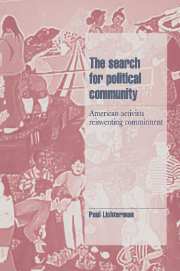Book contents
- Frontmatter
- Contents
- Acknowledgments
- 1 Personalism and political commitment
- 2 Personalized politics: the case of the US Greens
- 3 Speaking out in suburbia
- 4 Imagining community, organizing community
- 5 Culture, class, and life-ways of activism
- 6 Personalized politics and cultural radicalism since the 1960s
- 7 The search for political community
- Appendix I Choosing and studying the organizations
- Appendix II Why participant-observation was necessary
- Notes
- References
- Index
6 - Personalized politics and cultural radicalism since the 1960s
Published online by Cambridge University Press: 23 January 2010
- Frontmatter
- Contents
- Acknowledgments
- 1 Personalism and political commitment
- 2 Personalized politics: the case of the US Greens
- 3 Speaking out in suburbia
- 4 Imagining community, organizing community
- 5 Culture, class, and life-ways of activism
- 6 Personalized politics and cultural radicalism since the 1960s
- 7 The search for political community
- Appendix I Choosing and studying the organizations
- Appendix II Why participant-observation was necessary
- Notes
- References
- Index
Summary
FROM SPONTANEITY TO ROUTINE
In June 1967, “sobersided” older members and ex-members of Students for a Democratic Society (SDS) gathered to mull over the possibilities for a post-student political organization that could flower amid the youthful energy bursting out in counter-cultural color across the US. Bursting into the activists' plenary meeting were three self-appointed emissaries of the counter-culture. Taking center stage, they taunted and intrigued the assembly with news of its impotence before the allure of a free-love, freewheeling effervescence that was turning on America's youth. The weekend gathering never recovered from its strong hit of shock theater. It never got around to sketching plans for a new organization.
In 1989, at the national Green movement conference in Eugene, Oregon, authorized delegates and other Green activists had gathered to draft a movement platform to take back to their local chapters, and very optimistically, to a wider audience disenchanted with the two US political parties. In the middle of a tedious voting session, the back hallway doors banged several times to successive heave-hos and soon gave way before a missile-shaped cardboard protrusion. Chanting and yelling, a small band of people in torn jeans and sandals hoisted into the auditorium what turned out to be a twenty-foot cardboard reefer. The nominal leader of the Pot People, as they were tagged, insisted his small band would stall the session until the delegates added to their platform a demand for the repeal of marijuana laws.
- Type
- Chapter
- Information
- The Search for Political CommunityAmerican Activists Reinventing Commitment, pp. 182 - 212Publisher: Cambridge University PressPrint publication year: 1996

